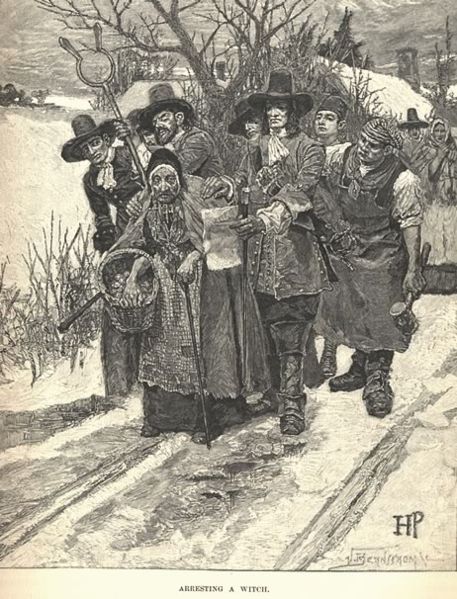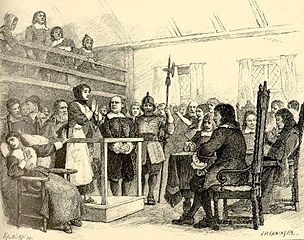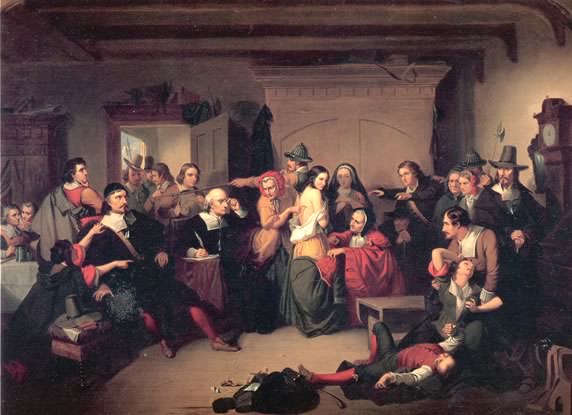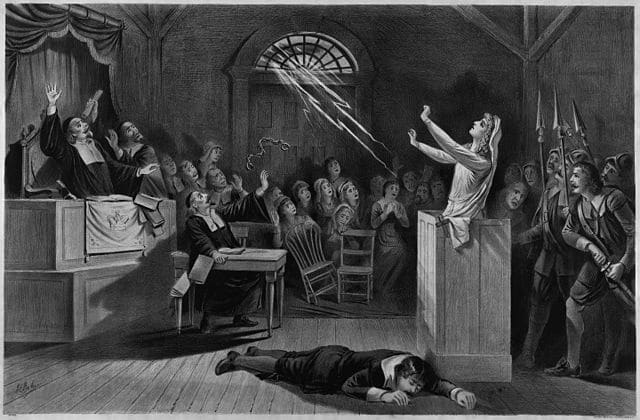More than 300 years later, the Salem witch trials testify to the way fear can ruin lives of innocent people and the importance of due process in protecting individuals against false accusations.
Some of those who insisted in 1787 that a Bill of Rights was necessary for the ratification of the Constitution undoubtedly knew about the treatment of the “Salem witches” and how they had been deprived of the rights to which they should have been entitled under English common law.
With the Bill of Rights in place, interpretations of the First Amendment consistently ruled that slander and defamation were not protected by the Constitution.
Women accused of being witches were slandered and denied rights
In January 1692 mass hysteria erupted in Salem Village, Massachusetts, when the specter of witchcraft was raised after several young girls became unaccountably ill. During the ensuing chaos, many Puritan ministers quoted Exodus 22:18, “Thou shalt not suffer a witch to live,” and encouraged their flocks to oust the evil in their midst. The hysteria only increased when noted Boston minister Cotton Mather joined in the fray. During the trials held in Salem town in Essex County, the accused were slandered with little recourse and denied rights that should have been granted under English common law.

In January 1692 mass hysteria erupted in Salem Village, Massachusetts, when the specter of witchcraft was raised after several young girls became unaccountably ill. The accused were slandered with little recourse and denied rights that should have been granted under English common law. This illustration is a depiction of the arrest of a witch during the Salem witch trials. (“Arresting a Witch,” Howard Pyle, 1883, public domain via Wikimedia Commons)
Technically, those accused of practicing witchcraft, or their next of kin, could respond to accusations by filing charges of defamation against their accusers. However, defendants won only four of fifteen such cases filed. Those convicted of defamation or slander were forced to pay fines and apologize publicly, but the more typical scenario was for courts to charge the accused with lying and add fines or additional punishment.
Bearing false witness and committing perjury were considered felonies in Salem; under normal conditions, those convicted of such charges were prosecuted in public forums. During the witch trials, however, individuals convicted of perjury could save themselves from public humiliation by accusing their neighbors. Most defendants lacked benefit of counsel and were assumed guilty. Those who publicly questioned the guilt of a defendant were likely to be accused of witchcraft themselves.
It was virtually impossible to disprove charges of witchcraft in Salem, and defendants were convicted with no evidence other than personal accusations, the presence of a “devil’s mark” on their bodies, or because they failed one of the so-called “witch tests.” The courts accepted spectral evidence, that is, evidence based on otherwise invisible spirits that the accusers claimed to be able to see.
Most accusers were teenage girls
Mostly populated by Puritans, Salem Village was experiencing economic hardship in 1692, and residents were only too willing to blame someone else for their troubles. The accusers were generally young females between the ages of 11 and 20. The mischief began when a group of girls accused Tituba, a slave from South America who had told their fortunes, of witchcraft after they became mysteriously ill. Responding to increased attention, the girls expanded their credibility by producing a plethora of new evidence against accused witches and spreading the hysteria to neighboring towns.
Chief instigators included twelve-year-old ringleader Ann Putnam, Elisabeth Hubbard, Mary Walcott, Mary Warren, Elisabeth Proctor, Mercy Lewis, Susan Sheldon, and Elizabeth Booth. Encouraged by their elders and joined by some peers, the girls began accusing anyone they disliked or feared of being witches. In court, the girls submitted anecdotal evidence and exhibited strange behavior, including weeping, joking, jerking, barking, writhing, and screeching, to suggest that their accusers were using magic to attack them.

The Salem witch trials escalated until 180 residents had been accused of witchcraft. Ultimately, 19 individuals who had refused to admit guilt were hanged and another was pressed to death. Martha Corey, depicted here, was hanged for allegedly being a witch, and her second husband, Giles Corey, was pressed to death. (“Martha Corey,” John W. Ehninger, 1902, public domain via Wikimedia Commons)
Some accused admitted guilt in order to save their lives
Told that they would be shown mercy if they confessed, 54 of the accused witches admitted guilt. Families and friends often urged their loved ones to confess to save their lives. Families sometimes turned on one another. When Margaret Jacobs confessed to witchcraft, she implicated several others, including her grandfather, Reverend George Burroughs.
From February to May, events escalated until 180 residents had been accused of witchcraft. Formal action was taken against 144 individuals, who were often chained and thrown in jail for months under harsh conditions. At least 55 of the accused were tortured or terrified into admitting guilt. Neither the young nor the old were spared. Four-year-old accused witch Dorcas Good went insane after spending months in prison and watching her baby sister die while in jail with their mother, who was later hanged. Three women and two infants died while imprisoned.
Ultimately, 19 individuals who had refused to admit guilt were hanged and another was pressed to death.
For centuries, scholars have attempted to identify similarities among the accused. Most agree that those accused of witchcraft tended to be eccentric individuals who stood out from their Puritan neighbors in some way. Quakers, for example, were easy targets. Most of the accused were Godfearing individuals and respected townspeople.

During periods of national crisis and stress, Congress has conducted investigations of Communists and other outsiders that have sometimes been likened to “witch hunts,” referring to the Salem Witch Trials. The First Amendment has generally protected individuals for opinions that they have expressed. This painting is a depiction of a Salem witch trial. (“Examination of a witch,” Tompkins Harrisson Matteson, 1853, public domain via Wikimedia Commons)
Massachusetts began the atonement process
After the hysteria was over, Massachusetts recognized the witch trials for what they were and began a centuries-long process of atonement. Judges, juries, and accusers publicly apologized, but the apologies were of little comfort to affected families. By 1711 the state had exonerated the accused from all wrongdoing and offered monetary compensations to surviving family members. In 2002 the Massachusetts state legislature officially cleared the names of the last of the accused witches.
During periods of national crisis and stress, particularly during the first Red Scare and later during the Cold War, the government has initiated prosecutions and Congress has conducted investigations of Communists and other outsiders that have sometimes been likened to “witch hunts.” The First Amendment has generally served to protect individuals for opinions that they have expressed, albeit not for violent or illegal conduct.
The Salem witch trials were also the subject of Arthur Miller’s The Crucible, written in the 1950s. Many read Miller’s play as a criticism of McCarthyism, the Red Scare, and intolerance. The Crucible itself has met with censorship in some communities and has been banned from some schools.
This article was originally published in 2009. Elizabeth Purdy, Ph.D., is an independent scholar who has published articles on subjects ranging from political science and women’s studies to economics and popular culture.

